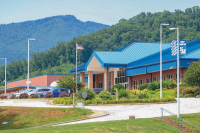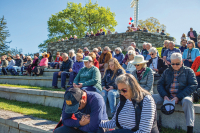Highway marker, exhibit to honor victims of incarcerated labor
 Cowee Tunnel, pictured here in the 1890s, was constructed using incarcerated laborers. Courtesy of Western Carolina University Hunter Library Special Collections
Cowee Tunnel, pictured here in the 1890s, was constructed using incarcerated laborers. Courtesy of Western Carolina University Hunter Library Special Collections
Two projects will come to fruition this month that honor the lives of those who were victims of incarcerated labor in Western North Carolina during the Jim Crow era — a highway marker in Dillsboro, and an exhibit at the Mountain Heritage Center in Cullowhee.
“This story really needed to be told and brought to the community,” said Danielle Duffy, graduate student and guest curator at the Mountain Heritage Center.
The Jackson County branch of the NAACP recently pro posed and wrote the copy for a historical highway marker to recognize the Cowee 19 — 19 incarcerated laborers who drowned in late December of 1882 building the Cowee train tunnel on the Murphy Branch of the Western North Carolina Railroad.
“[The NAACP] did the heavy lifting,” said Duffy. “They did the research, they applied for it and got the highway marker accepted.”
During that time frame, Duffy had proposed that an exhibit be set up in the Mountain Heritage Center about the Cowee 19, the incarcerated labor system and convict leasing. Because of that work, the NAACP asked Duffy and her team to take over the dedication event for the highway marker, which will precede the opening of the Mountain Heritage Center exhibit by just two days.
“The Mountain Heritage Center is a resource for the entire area when it comes to heritage or history or these kinds of cultural aspects,” said Duffy. “So, it fit really well within this organization.”
Related Items
The highway marker will serve to recognize not just the Cowee 19, but also incarcerated laborers more broadly as well.

The practice of leasing prisoners, many of whom were sentenced for minor crimes and were disproportionately Black, was common in North Carolina and other states following the Civil War. The state cashed in on the labor of prisoners by employing them on public and private works projects and leased them out to farms and companies engaged in infrastructure projects.
According to a state press release on the highway marker, from 1870-90, an average of 65% of the state’s prison population was used to build the Western North Carolina Railroad, opening a more efficient method of transporting travelers and supplies into Asheville and locations further west.
“The brutality and racial inequity of the convict labor leasing system in North Carolina was illustrated by the December 1882 Cowee Tunnel disaster, in which 19 Black men drowned near Dillsboro,” the Historical Highway Program acknowledged in a press release. “A boat carrying them across the Tuckasegee River capsized, and the prisoners, shackled with leg irons, were unable to swim to shore.”
The use of incarcerated labor to build railroads and other infrastructure projects continued well into the 20th century. By 1933, road construction and maintenance and incarcerated labor were so closely linked that the North Carolina General Assembly consolidated the state’s prison system and the highway commission. This continued until their separation in 1957.
The commemorative sign will read “Incarcerated Laborers: Many arrested under Jim Crow laws; leased from the state to build WNC Railroad. Many died, including 19 who drowned near Cowee Tunnel, 1882.”

The Cowee 19 were working to construct the Cowee tunnel when they drowned in the Tuckasegee River. Braulio Fonseca photo
The North Carolina Highway Historical Marker program has been operating since 1935 to share concise accounts of North Carolina’s history. There are over 1,600 markers statewide — the familiar looking silver and black plaques with a few sentences and the state seal — that cover a broad range of topics.
The program is intended to spark interest and encourage deeper exploration of North Carolina history, both good and bad, tragic and heroic.
This new marker in Dillsboro will be officially unveiled on Saturday, May 4, at the intersection of U.S. 23/441 and Haywood Road. Because this is a busy intersection, the event at that location is open on an invite-only basis.
However, the rest of the community can join in the ceremony at 3 p.m. Saturday at Innovation Station in Dillsboro. There will be live music by Liberty Baptist Church choir, remarks by Leslie Leonard, head of the historical highway marker program, Danielle Duffy and others.
Duffy is a graduate student at Western Carolina University in the history department focusing on public history. She is the guest curator of the upcoming exhibit “Shadows of Incarceration: The Cowee 19 Story,” that will be on display at the Mountain Heritage Center from May 6 through Dec. 13. The exhibit examines the lives of the individuals from across North Carolina that were trapped by the early Jim Crow judicial system and forced to work and sacrifice for the creation of the New South.
“The exhibit is a project that I started working on a number of years ago stemming from a class assignment to write a historical site nomination. I chose to do the prison labor camp, the tunnel, the trestle bridge and the approximate burial ground as a historical nominated site,” said Duffy. “Through that work, I really felt that this story needed to be told and brought to the community.”
Duffy had heard these stories, as many WNC residents have, swirling around in the community consciousness, but she felt like it needed something bigger. Something that the community and the people could interact with.

Incarcerated laborers built much of the Western North Carolina Railroad, including the trestle bridge near Dillsboro (right). Braulio Fonseca photo
Duffy conducted research at the graduate school with the help of grants and came up with the concept for the exhibit in coordination with the Mountain Heritage Center and community stakeholders that included members of the local NAACP, other professors on campus, businesses in the Sylva area, Appalachian artist and storyteller Ann Miller Woodford and others.
The exhibit will open May 6 with an opening event on May 23 that will include an artist talk with Woodford who created an interpretive painting for the exhibit.
“We don’t have any imagery of the Cowee prison labor camp, of any of the incarcerated laborers on the Murphy branch of the Western North Carolina Railroad,” said Duffy. “So, we partnered with [Woodford] to create that imagery for us.”
This type of work and research has long been a passion for Duffy, who says that recognizing the lives of these individuals and trying to understand their human situation is of paramount importance to her.
“It’s really exciting for me to be able to create something that I hope the community can take something away from, and that can open their eyes to why we have the criminal justice system that we have today,” said Duffy. “My hope is that this work reflects not only the community that we live in, and the morals that we hold, but brings some kind of deeper understanding to where we are today.”
Want to go?
A ceremony for the unveiling of the highway marker commemorating incarcerated laborers and the Cowee 19 will be held at 3 p.m. Saturday, May 4, at Innovation Station in Dillsboro.
“Shadows of Incarceration: The Cowee 19 Story,” will be on display May 6 through Dec. 13 at the Mountain Heritage Center in Cullowhee, with a grand opening to be held May 23.
The exhibition examines the history of incarcerated labor in Jackson County. It details how the Reconstruction-era legal system allowed private companies to “lease” the labor of prisoners.
The student-curated exhibit provides an opportunity to learn about a local tragedy when 19 men and boys drowned in the Tuckasegee River in 1882. The incident happened as they crossed the river to work on a tunnel for the Western North Carolina Railroad.
In addition to biographies of the people who perished, the exhibit includes a prison camp life diorama and an original painting by noted visual artist Ann Miller Woodford of Andrews. Due to the lack of photographs from prison camps in the 19th century, Woodford’s work and era-appropriate vignettes add to the exhibition experience.
The new exhibit is free to the public and will be on display through Dec. 13. The MHC is open Monday through Friday from 10 a.m. to 4 p.m. or by appointment and is closed on weekends and university holidays.
For more information, contact Andrea Spooner, MHC museum operations coordinator, at This email address is being protected from spambots. You need JavaScript enabled to view it. 828.227.3191.













